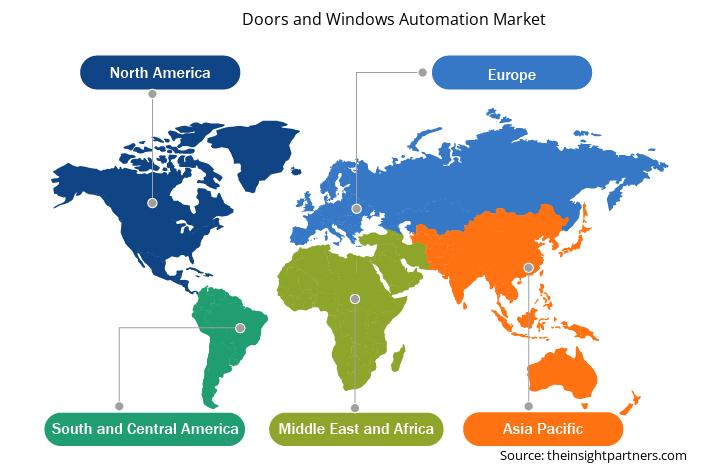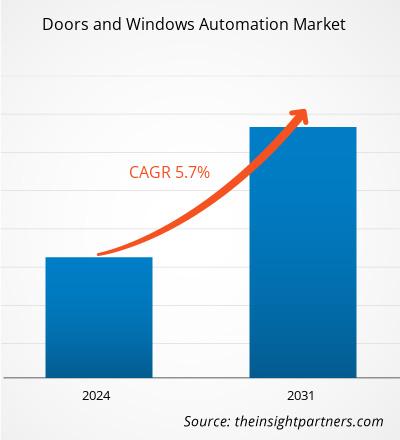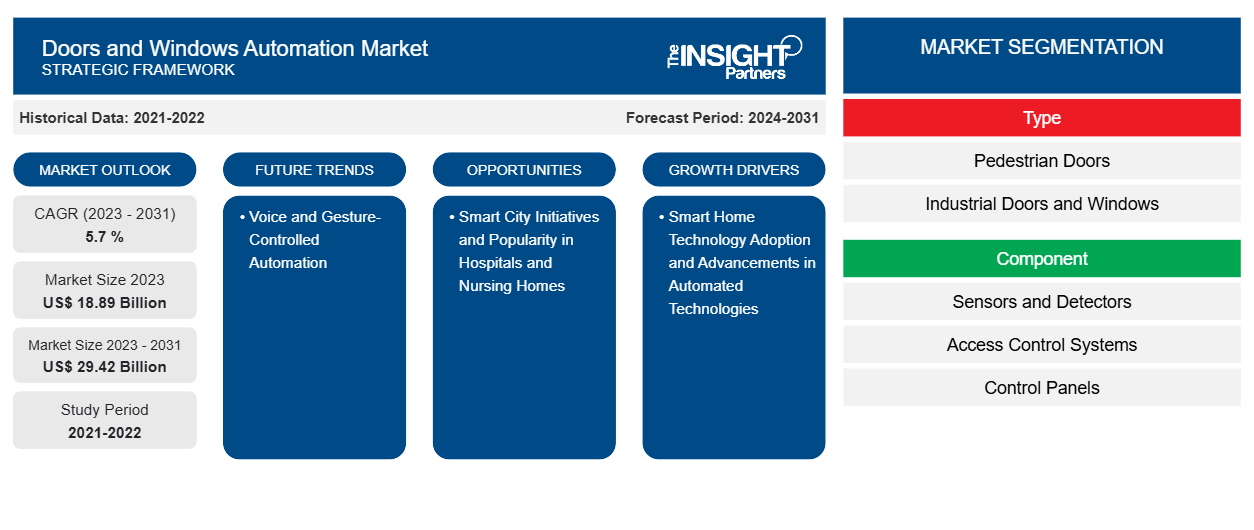门窗自动化市场规模预计将从 2023 年的 188.9 亿美元增至 2031 年的 294.2 亿美元。预计 2023-2031 年期间市场复合年增长率将达到 5.7%。语音和手势控制自动化很可能在未来几年为门窗自动化市场带来新趋势。
门窗自动化市场分析
智能家居技术的采用和自动化技术的进步等因素正在推动门窗自动化市场的发展。由于智慧城市计划的增多以及医院和疗养院中自动化系统日益普及,预计该市场将在预测期内增长。对门窗自动化解决方案的需求由几个关键因素驱动,包括住宅和商业建筑对便利性、安全性和能源效率日益增长的需求。智能家居系统的集成、语音和手势控制以及运动传感器等技术进步正在增强用户体验并实现无缝自动化。对可持续性的日益关注也促进了市场的增长,因为自动门窗可以优化通风并降低能耗,从而节省成本。此外,人们的卫生意识不断增强,尤其是在医疗保健和商业环境中,加速了非接触式自动化系统的采用。这些因素,加上城市化和对智能互联家居日益增长的偏好,正在推动市场的扩张。
门窗自动化市场概况
门窗自动化是指集成先进技术,使门窗能够自动运行,从而提高便利性、安全性、能源效率和可访问性。这种自动化可以通过传感器、电机和控制系统实现,这些系统可以根据特定条件或用户命令打开或关闭门窗。常见功能包括无接触、语音激活或手势控制操作,以及与家庭自动化系统的智能集成,通过 Amazon Alexa 或 Google Assistant 等平台进行无缝控制。这些自动化系统越来越多地用于住宅和商业建筑,具有增强安全性、通过优化通风节省能源以及通过减少与表面的物理接触改善卫生等好处。
定制此报告以满足您的需求
您可以免费定制任何报告,包括本报告的部分内容、国家级分析、Excel 数据包,以及为初创企业和大学提供优惠和折扣
-
获取此报告的关键市场趋势。这个免费样品将包括数据分析,从市场趋势到估计和预测。
门窗自动化市场驱动因素和机遇
智能家居技术采用
随着房主寻求更大的便利性、舒适性、能源效率和安全性,智能家居采用了门窗自动化系统。作为智能家居技术更广泛趋势的一部分,随着联网设备的日益普及,消费者越来越多地将自动化系统融入家中,以增强日常生活体验并降低能源消耗。Marvin、Somfy、WindowMaster 和 View Glass 等公司提供将自动门窗连接到智能家居的先进解决方案。例如,2023 年 9 月,全球领先的室内窗帘和室外遮阳电机制造商 Somfy 宣布与 Apple Home 集成并获得认证。该认证使 Somfy 支持的用于室内窗户应用的 Zigbee 电机与 TaHoma 开关与 Apple Home 无缝兼容。Zigbee 3.0 技术是一种全球采用的安全物联网解决方案,通过将智能家居设备连接到统一网络来促进互操作性,使产品能够顺利运行。新的集成提供了一种简单而安全的方法,可以通过 iPhone、iPad、Apple Watch、HomePod 和 Mac 等设备上的 Apple Home 应用程序和 Siri 控制 Somfy 电动窗帘,使用 Zigbee 电机。因此,智能家居技术的采用推动了门窗自动化市场的发展。
智慧城市计划
城市技术越来越先进,联系越来越紧密,对自动化基础设施的需求也越来越大,这些基础设施可以优化建筑运营、增强安全性并提高能源效率。根据联合国发展计划署的数据,全球 60% 以上的人口居住在城市,其中 70% 以上是劳动人口;此外,全球 80% 的经济价值是在城市中创造的。各国政府都在积极建设智慧城市,重点是利用互联网共享信息、提高运营效率,并为居住在智慧城市的公民提供更优质的服务。例如,根据城市发展部的数据,印度 100 个城市共有 8,033 个(智慧城市任务)项目,其中 7,038 个(88%)已经完成,995 个(12%)正在实施中。同样,中国政府在 2023 年宣布了建设 500 多个智慧城市的计划。 2023 年 7 月,政府资助了一项价值 2 亿美元的项目,用于开发广州智慧城市项目一期。智慧城市计划涉及采用各种智能技术,包括门窗自动化系统,使运营更加节能和可持续,并最大限度地减少碳排放。此外,在迪拜,几座商业建筑正在采用自动门窗,这是该市成为世界顶级智慧城市之一的愿景的一部分,支持智能技术的整合,以实现可持续性和便利性。此外,迪拜继续在智慧城市发展方面处于领先地位,迪拜硅谷绿洲等项目采用自动门窗来优化商业和住宅建筑的能源效率。这些系统旨在根据天气条件自动调整,有助于节约能源并实现城市减少碳排放的目标。因此,预计智慧城市项目中越来越多的举措将在预测期内为市场增长创造各种机会。
门窗自动化市场报告细分分析
有助于门窗自动化市场分析的关键部分是类型、组件、控制系统和行业垂直。
- 根据类型,门窗自动化市场分为窗户、工业门和行人门。行人门细分市场在 2023 年占据了市场主导地位。
- 就组件而言,门窗自动化市场分为门禁系统、控制面板、传感器和探测器、电机和执行器等。传感器和探测器部分在 2023 年占据了最大的市场份额。
- 根据控制系统,门窗自动化市场分为全自动、半自动和动力辅助。全自动细分市场在 2023 年占据了市场主导地位。
- 根据行业垂直划分,门窗自动化市场分为住宅、商业和工业。2023 年,商业部门在门窗自动化市场中占有最大份额。
门窗自动化市场份额按地区分析
门窗自动化市场分为五大区域:北美、欧洲、亚太地区 (APAC)、中东和非洲 (MEA) 以及南美和中美。2023 年,北美占据市场主导地位,其次是欧洲和亚太地区。
北美门窗自动化市场分为美国、加拿大和墨西哥。北美主要国家的智能家居和智能城市项目正在大幅增加。该地区各国政府都在鼓励采用智能城市,这有望推动住宅和商业建筑活动,并刺激对自动门窗的需求。将自动化技术集成到门窗系统中有助于节省能源,因为它有助于在最佳时间内保持门窗锁定或解锁。
门窗自动化市场区域洞察
Insight Partners 的分析师已详细解释了预测期内影响门窗自动化市场的区域趋势和因素。本节还讨论了北美、欧洲、亚太地区、中东和非洲以及南美和中美洲的门窗自动化市场细分和地理位置。

- 获取门窗自动化市场的区域特定数据
门窗自动化市场报告范围
| 报告属性 | 细节 |
|---|---|
| 2023 年的市场规模 | 188.9 亿美元 |
| 2031 年市场规模 | 294.2亿美元 |
| 全球复合年增长率(2023 - 2031) | 5.7% |
| 史料 | 2021-2022 |
| 预测期 | 2024-2031 |
| 涵盖的领域 |
按类型
|
| 覆盖地区和国家 |
北美
|
| 市场领导者和主要公司简介 |
|
门窗自动化市场参与者密度:了解其对业务动态的影响
门窗自动化市场正在快速增长,这得益于终端用户需求的不断增长,而这些需求又源于消费者偏好的不断变化、技术进步以及对产品优势的认识不断提高等因素。随着需求的增加,企业正在扩大其产品范围,进行创新以满足消费者的需求,并利用新兴趋势,从而进一步推动市场增长。
市场参与者密度是指在特定市场或行业内运营的企业或公司的分布情况。它表明在给定市场空间中,相对于其规模或总市场价值,有多少竞争对手(市场参与者)存在。
在门窗自动化市场运营的主要公司有:
- ABB有限公司
- 安朗吉恩公司
- 亚萨合莱公司
- 卡梅公司
- 霍尼韦尔国际公司
- 英斯坦
免责声明:上面列出的公司没有按照任何特定顺序排列。

- 获取门窗自动化市场顶级关键参与者概览
门窗自动化市场新闻和最新发展
门窗自动化市场通过收集一手和二手研究后的定性和定量数据进行评估,其中包括重要的公司出版物、协会数据和数据库。门窗自动化市场的一些关键发展如下所列:
- Allegion plc 通过其子公司之一收购了 SOSS Door Hardware (SOSS)。SOSS 是优质铰链和门五金件的领先制造商,主要在北美非住宅市场销售其解决方案。SOSS 解决方案与该公司的 Ives、Glynn-Johnson 和 Zero International 门五金件相得益彰,使他们能够为客户指定和供应更广泛的产品组合,并最终发展这一核心业务。
(来源:Allegion plc,新闻稿,2024 年 10 月)
- ABB 在今年法兰克福的 Light + Building 贸易展览会上发布了其 ABB-Welcome 门禁系统产品组合的升级版。新一代 ABB-Welcome 和 ABB-Welcome IP 具有改进的设计、简化的系统架构和增强的连接性。ABB-Welcome 提供多功能的双线门禁通信解决方案,具有多种模块化设计。它包括全系列的室外和室内站。住宅入口区域(包括大门和前门或入口门)可以方便地连接到手机,以便更快地响应门口的呼叫;此外,可以通过应用程序远程授予访问权限。
(来源:ABB,新闻稿,2024 年 3 月)
门窗自动化市场报告范围和交付成果
“门窗自动化市场规模及预测(2021-2031)”对以下领域进行了详细的市场分析:
- 门窗自动化市场规模及全球、区域和国家层面所有关键细分市场的预测
- 门窗自动化市场趋势以及市场动态,如驱动因素、限制因素和关键机遇
- 详细的 PEST 和 SWOT 分析
- 门窗自动化市场分析涵盖主要市场趋势、全球和区域框架、主要参与者、法规和最新市场发展
- 行业格局和竞争分析,涵盖市场集中度、热点图分析、知名参与者以及门窗自动化市场的最新发展
- 详细的公司简介
- 历史分析(2 年)、基准年、预测(7 年)及复合年增长率
- PEST和SWOT分析
- 市场规模、价值/数量 - 全球、区域、国家
- 行业和竞争格局
- Excel 数据集
近期报告
相关报告
客户评价
购买理由
- 明智的决策
- 了解市场动态
- 竞争分析
- 客户洞察
- 市场预测
- 风险规避
- 战略规划
- 投资论证
- 识别新兴市场
- 优化营销策略
- 提升运营效率
- 顺应监管趋势























 获取免费样品 - 门窗自动化市场
获取免费样品 - 门窗自动化市场